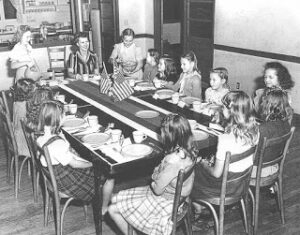Headaches of Overcrowding

(With COVID-10 my PPS children are missing overcrowding)
During WWII (1942-1945) the population of Oregon increased by 194,000 people. Housing shortages were mitigated by the rapid construction of public housing units. This had a rippling impact on school enrollment, which felt like a tsunami for families with children enrolled in public grade schools.
The Slabtown community witnessed the nearly instantaneous arrival of 10,000 people in a single development—the Guild’s Lake Courts wartime housing project, built predominantly on the landfill areas of Guild’s and Kittredge Lakes (now the NW Industrial Area) and on scattered plots in the Conway/XP Logistics region of Slabtown. Chapman, the local grade school, was soon bursting at the seams.

(Courtesy Guilds Lake History Project)
The new residents in Slabtown had come for defense work in steel companies and shipyards. The mass influx of the children of this new work force caught the school district off guard. There were an estimated 2,000 grade school-age children in the Guild’s Lake development in 1944. St. Patrick’s School, serving Catholic families, had an enrollment of 400. The other K-8 children of these war workers were assigned to Chapman Grade School, 1445 NW 26th Avenue. The capacity of this 1920s school building was 750 students. In 1941 there were 465 students enrolled; in 1942, 570 students. In November 1943 enrollment reached 1,600 students. Crowding would have been worse had over 100 children of Black families (who elected to keep their children out of school because of transportation and segregation concerns) also attempted to enroll. The district classified over 300 students in the Gona section of Guild’s Lake Courts as truants (high school was not required and was not part of any of these truancy figures). Linnton School was not a part of PPS District One in the 1940s but it absorbed students as well.

(Courtesy Guild’s Lake Courts History Project)
The school district’s “double shifting” plan had tenured students receiving instruction from 8 AM to 12:45 PM and the children of the new arrivals segregated into the 1 PM until 5 PM shift, but even this strategy was ineffective. Chapman’s principal, Charles A. Fowler, was turning students away and had as many as 47 students crowded into a single classroom under the guidance of a single teacher—a situation which he described to Richard Nokes of The Oregonian in November 1943 as “not so hot, educationally speaking.” Both the “regulars” and the “swamp kids”—the Guilds Lake children—were suffering from the overcrowding. Long-time members of the Chapman community advocated for constructing a new facility to relive crowding in the classrooms.
Eventually, Guild’s Lake School, built to educate 1,200 students, opened in the fall of 1944. Seventh and eighth grade students attending Guild’s Lake School from 1944 to 1950 would go to Chapman Grade School once or twice a week for mechanical shop and cooking class. I focused on this issue of crowding because Chapman is experiencing overcrowding again. 1940s was a wartime crisis, during the baby boom Chapman enrollment swelled and “temporary” portables were built to increase classroom capacity. Tragic that this school was demolished.
Update January 29, 2016:
I have received a few calls about this article. Many callers had questions about what happened to the school once the public housing was closed. Some individuals wanted more history on the school.
A number of years ago I volunteered on a team to create curriculum for the PPS 9th Grade Transitional Academy. That included an autobiographical account of life at Guild’s Lake by Chuck Charnquist who attended Chapman and Guild’s Lake School. Link to Mr. Charnquist’s Narrative. There is also the sample of primary source documents used by the instructors PPS must have created this link in-house, the point was to engage at risk students with history and their communities.
Additionally, PPS District I, used the structure as a wear house after the school according to a December 6, 1956 p 17 article about a robbery at the “warehouse” at 4275 NW Yeon in the Oregonian. The site itself was up for sale in 1968 (The Oregon Journal October 15, 1968 p 6 sec C col. 4). In 1973 the site was redeveloped as Freightline headquarters complex. There is history of the school being considered for use by the police academy in City Archives and Records Center scrapbooks. The Fall 1951 Guilds Lake School paper is the last issue in my collection of material gathers for the Guild’s Lake History Project the website for that project includes a chapter about Community Services Institution.
